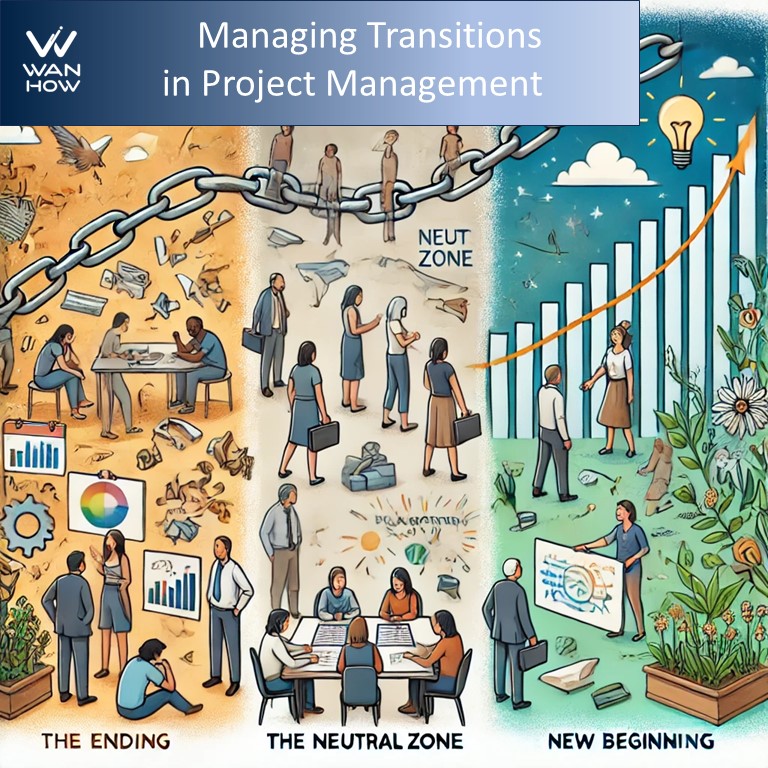
Managing transitions in project management is one of the most formidable challenges for a project manager. This is especially the case when you are tasked with cultivating buy-in on sensitive, contentious projects where staffing or budget changes are on the table. The “Ending, Losing, and Letting Go” stage of the transition model frequently becomes a sticking point, as overarching visions clash with individual and departmental plans and the status quo. Despite our best efforts to communicate the vision and the plan in various ways to facilitate alignment and understanding, acceptance is an entirely different beast that takes time and strategic handling.
Understanding the Challenge
At the heart of any contentious project lies the human element. Changes in staffing and budget allocations often strike at the core of an individual’s sense of stability and security. The “Ending, Losing, and Letting Go” stage is particularly challenging because it involves an emotional and psychological shift. People are being asked to abandon familiar routines, relinquish control, and embrace uncertainty.
Strategies for Cultivating Buy-In
- Empathetic Communication:
- Acknowledge Concerns: Start by recognizing the emotional impact of the changes. Validate their feelings and provide a safe space for expressing concerns.
- Transparent Information Sharing: Share as much information as possible about why the changes are necessary and how they align with the broader organizational goals. Transparency fosters trust and reduces resistance.
- Involving Stakeholders Early:
- Inclusive Decision-Making: Involve key stakeholders early in the planning process. This inclusion helps them feel valued and integral to the project’s success.
- Feedback Mechanisms: Implement feedback loops where stakeholders can voice their concerns and suggestions. This can be through surveys, focus groups, or regular meetings.
- Clear Vision and Benefits:
- Articulate the Vision: Clearly define the vision and objectives of the project. Help stakeholders understand the long-term benefits and how the changes will lead to a better future for everyone involved.
- Showcase Quick Wins: Demonstrate short-term successes and milestones to build momentum and show that the changes are leading to positive outcomes.
- Support Systems:
- Provide Training and Resources: Offer training programs and resources to help staff adapt to new roles or processes. Support systems ease the transition and reduce anxiety.
- Personal Support: Assign mentors or coaches to individuals who are struggling with the change. Personal support can significantly ease the transition process.
- Consistent Follow-Up:
- Regular Check-Ins: Schedule regular check-ins to monitor progress and address any ongoing concerns. Continuous engagement keeps the lines of communication open and shows that you are committed to supporting them through the transition.
- Adapt and Adjust: Be willing to adapt your approach based on feedback and changing circumstances. Flexibility demonstrates that you are responsive and considerate of stakeholder needs.
Applying Bridges’ Transition Model
Bridges’ Transition Model offers valuable insights into managing these challenging transitions by breaking the process into three stages: Ending, Losing, and Letting Go; The Neutral Zone; and The New Beginning. Each stage requires a distinct approach to help individuals move forward.
Stage 1: Ending, Losing, and Letting Go
This initial stage is marked by resistance and emotional upheaval. People may experience fear, denial, anger, sadness, disorientation, frustration, uncertainty, and a sense of loss.
Guiding People Through Stage One:
- Acknowledge Emotions: Recognize and validate the emotional impact of the changes without judgment. Allow time for reflection and discussion.
- Empathetic Listening: Encourage open conversations about what people will miss and what they have achieved. Listen empathetically and communicate openly.
- Highlight Continuity: Emphasize how accumulated skills and experience will be valuable in the new environment. Reassure them that the best parts of the past will be remembered and celebrated.
Stage 2: The Neutral Zone
In this stage, people often feel confused, uncertain, and impatient. They may experience resentment, low morale, anxiety, and skepticism. However, this stage can also be one of great creativity, innovation, and renewal.
Guiding People Through Stage Two:
- Normalize Feelings: Let the team know it’s okay to feel lost or unsettled. Remind them of team goals and encourage them to express their feelings.
- Frequent Feedback: Meet regularly to provide feedback and set short-term goals to offer quick wins and boost motivation.
- Boost Morale: Continue to boost morale and remind people of their contribution to the change’s success. Manage workloads to prevent burnout.
Stage 3: The New Beginning
This final stage is marked by acceptance and energy. People begin to embrace the change, build necessary skills, and see early wins.
Guiding People Through Stage Three:
- Sustain Momentum: Help sustain the change by linking personal goals to organizational objectives. Highlight stories of success brought about by the change.
- Celebrate Achievements: Take time to celebrate the change and reward hard work. However, remain vigilant and support those who may slip back to previous stages.
Conclusion
Managing transitions and cultivating buy-in on sensitive or contentious projects is undoubtedly challenging, but with empathetic communication, inclusive decision-making, a clear vision, robust support systems, and consistent follow-up, it is possible to navigate the complexities of the “Ending, Losing, and Letting Go” stage. Acceptance takes time, but through persistent effort, patience, and strategic handling, you can steer your team toward alignment and shared success. Remember, change is a journey, and your role as a project manager is to guide your team through it with compassion, clarity, and confidence. By applying Bridges’ Transition Model, you can better understand and support your team through each stage of the transition, ultimately fostering a more resilient and adaptable organization.
Related Post
Navigating the Project Management Life Cycle: A Comprehensive Guide
